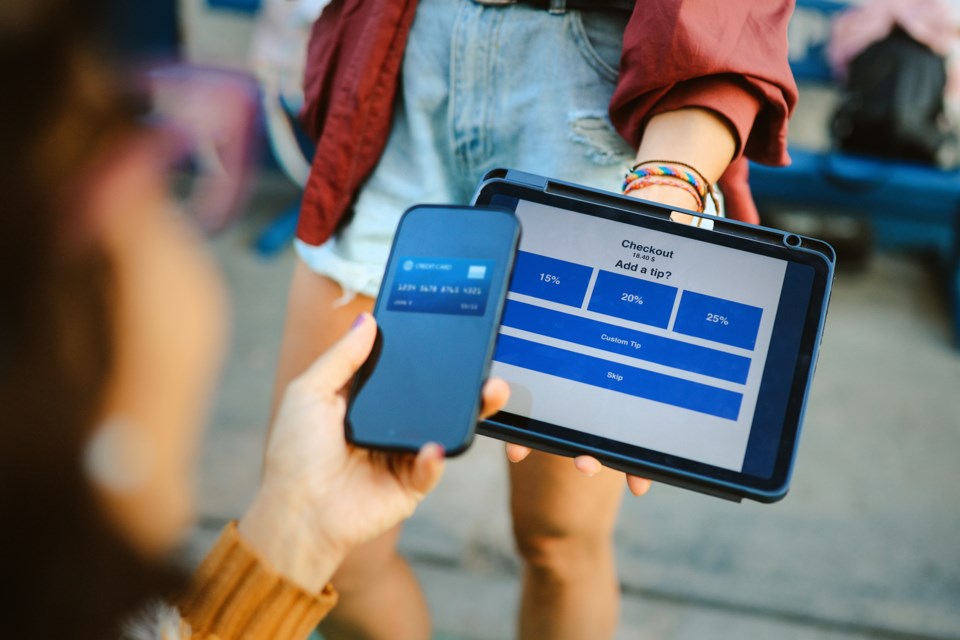Reminders to tip your server or service provider are everywhere: On credit card terminals at coffee shops and restaurants, on many of the apps we use, at other retailers and even on the menus at restaurants near Vancouver’s cruise ship terminal — in several languages.
More than three in five Canadians aged 55 and over (64 per cent) say they tip “all the time,” along with 56 per cent of those aged 35 to 54, and 41 per cent of those aged 18 to 34. Women are more likely to say they tip all the time at sit-down restaurants (55 per cent) than men (51 per cent).
Canadians in the highest income bracket are more likely do this (67 per cent) than those in the middle and lowest brackets (56 per cent and 41 per cent, respectively). The same is true for over half of those who voted for the Liberal Party (52 per cent), the Conservative Party (55 per cent) and the NDP (65 per cent) in last month’s federal election.
Food servers at sit-down restaurants can expect tips “all the time” from majorities of customers in Quebec (57 per cent), Ontario (55 per cent), Atlantic Canada (54 per cent), Alberta (also 54 per cent) and B.C. (52 per cent). In Saskatchewan and Manitoba, the proportion drops to 41 per cent.
These findings suggest that sizable proportions of Canadians are not convinced about tipping being quasi-mandatory, at a time when customers are being urged to dig deep. Majorities of Canadians disapprove of sit-down restaurants providing a suggested tip printed on the cheque or bill (57 per cent) and prompting for a suggested tip when the customer uses a credit card (53 per cent). Opposition to these two practices is particularly high with Canadians aged 55 and over (71 per cent and 61 per cent, respectively).
Animosity towards suggested tips climbs even further in two other instances. More than seven in 10 Canadians (71 per cent) disapprove of online retailers prompting for a suggested tip and almost two-thirds (65 per cent) feel the same way about coffee shops.
There is a split on sit-down restaurants setting a minimum service charge for large parties. While 45 per cent of Canadians approve, 47 per cent don’t.
When we asked Canadians about acceptable tips in specific circumstances, the differences are staggering. Majorities say no tip is required when ordering goods online (57 per cent) or picking up food to go (also 57 per cent). About one in four never tip when getting food delivery though a third-party app or after taking a taxi or rideshare vehicle, and slightly fewer never tip when getting food delivery managed by the restaurant (19 per cent), or after a haircut or visit to a salon (17 per cent).
For about a third of Canadians, the “sweet spot” is a tip between 10 per cent and 14 per cent for a haircut, food delivery managed by the restaurant, food delivery through a third-party app, or after a taxi or rideshare service.
Regardless of our personal feelings, the circumstances of the service industry are inescapable for most Canadians. Almost seven in 10 (69 per cent) agree that if the salaries of food servers were better, there would be no need to tip them. A similar proportion (68 per cent) understand that food servers cannot get by on their salaries alone.
Still, just over three in five Canadians (61 per cent) disagree with the concept of food servers deserving a tip in all circumstances, even if the service was bad, and almost two-thirds (65 per cent) believe food servers nowadays simply expect a tip, but don’t work hard to earn it.
Our data suggests that a female NDP voter of European descent in the highest income bracket who resides in Quebec or Ontario is the best bet for a tip after a meal at a sit-down restaurant. If you find her, make her a regular customer.
Mario Canseco is president of Research Co.
Results are based on an online survey conducted from May 4-6, 2025, among 1,001 adults in Canada. The data has been statistically weighted according to census figures for age, gender and region in Canada. The margin of error is plus or minus 3.1 percentage points, 19 times out of 20.




